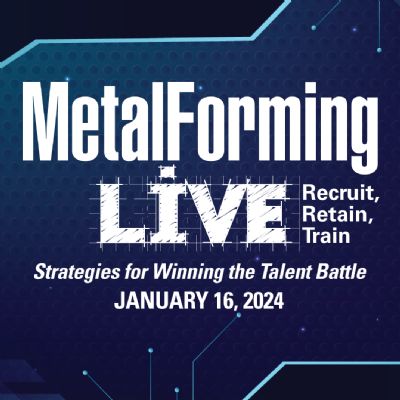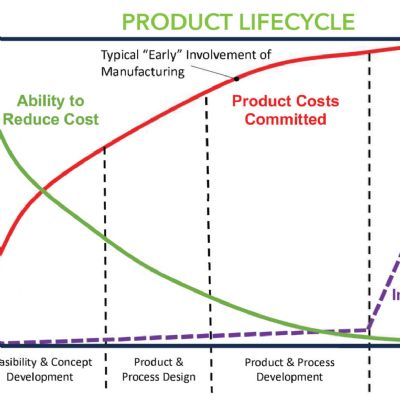Sopko expects that the knowledge gained while developing this testing procedure will be applied for other applications.
“Our up-front cost to develop a new process such as this is huge, and the R&D tax credit goes a long toward helping us justify the investment,” he says. Sopko was able to file amended tax returns over a three-year time period, which, thanks to the R&D tax credit, yielded three separate refund checks that totaled in the six figures, money he used to pay down debt for his company.
“All American manufacturers should become familiar with the tax credit,” Sopko says, “and take the time to see how they can make it work to their advantage.”
Deep-Draw Development at Larson
Chuck Cederberg, president of Larson Tool and Stamping, Attleboro, MA, has found the R&D tax credit vital as his company develops new techniques to supply precision metal stampings, deep-drawn cylinders and assemblies.
“The tax credit helps defray the money invested in research and development when developing new or improving existing manufacturing processes,” Cederberg says, describing a recent R&D project that had the firm looking to improve deep-draw procedures used to form cylinders. Larson wanted to improve efficiency and quality by using new technologies on the production line, including zig-zag feeding, coil staging and innovative inline press design. The goals: Reduce material usage, downtime, labor costs and the amount of floor space taken up by the equipment. The company also wanted to add safety features and improve the reliability of equipment operation.
Time, cost and size constraints placed on the project resulted in considerable technical uncertainty. Larson’s product line operates six days a week, so performing R&D on the line had to minimally affect the production schedule. Also, Larson Tool’s cost constraints prevented complete replacement of all three presses in the line. In addition, limited floor space created challenges.
The existing line employed a straight feed of coil stock into a press that blanked a hole into the steel as it fed through the line. By replacing the feed system with a zig-zag feeder, which moves coil laterally, the press now blanks offset holes, which has significantly improved material utilization and reduced scrap. Also, scrap now falls into a disposal bin without operator assistance, eliminating manual scrap handling.
As a result of this project, Larson Tool improved its production process used to deep-draw cylinders, with much of the man-hours and equipment-purchase costs applying toward generating a significant R&D tax credit.
“The R&D tax credit is a highly technical part of the tax code,” says Cederberg, “and because of its complexity, companies would be best served by retaining a specialty firm to initially walk them through the process, and ensure that nothing is left on the table.”
Recouping Prototype-Development Costs at K&S
“At K&S Tool, Die & Manufacturing, Inc. (Ixonia, WI), we often provide development and prototype work for our customers, when it comes to building metal-stamping dies,” says Cis Allison, executive vice president and CFO. “We didn’t realize that how much of the labor used to develop prototypes actually qualifies for the R&D tax credit. We thought that the tax credit only benefited big OEMs.”
One recent project at K&S Tool involved developing a more functional, reliable and less-expensive sensor cover for pipelines. The sensor cover seals and protects sensitive electronic components used to monitor pressure and flow. The first challenge was making the product cost efficient. Prior to the R&D project, K&S fabricated the sensor cover as a welded assembly of several parts. Its engineers worked to consolidate the assembly into fewer parts and eliminate all of the finishing processes, to minimize labor costs. In doing so, they had to balance cost against strength because the cover must meet pressure-vessel specifications. The entire design process was further complicated by the fact that K&S was just developing the tooling, so the engineers had to work with its existing presses. This limited their options regarding die size, tonnage and press-cushion pressure.
K&S experimented with designs using simulation software, and its engineers determined that they would not be able to manufacture the initially recommended design because it had numerous sharp corners and abrupt creases and corner changes. After demonstrating that the design would need to be modified, K&S began working with the simulation software to produce a new part design.
The engineers experimented with different draw radii before identifying the optimum balance between strength and cost, and also investigated different die conditions to eliminate wrinkling. As a result of the development process, they reduced the draw radius on the sides and incorporated draw beads in certain areas. They then ran experiments on the press that revealed that the part would spring inward after it was removed from the die, because of latent stress in the shell, so they increased the size of the part to compensate for the inward spring. Lastly, when K&S tested the resulting die in the customer’s presses, further development was needed. The customer’s press is a hydraulic model, capable of varying the ram speed. But, K&S employs only mechanical presses. To get the die to run properly in the hydraulic presses, K&S engineers had to increase the pressure on the binder to compensate for the slower drawing speed of the hydraulic presses. They also researched the lubricant being used, and selected a new formulation for the application.
The extensive and time-consuming R&D process allowed K&S engineers to produce a drawn part that exceeded goals for cost reduction and durability set by the customer. And, best of all, “the process fell within the realm of the R&D tax credit,” adds Allison. “With the help of Black Line Group, we captured all of the necessary information to take advantage of a tax credit that most small companies like us might overlook. By claiming the credit, the federal government reimbursed our company 6.5 percent of the qualified expenditures for the project. And, we were able to go back to the open tax years and file amended tax returns. The net cumulative dollars reimbursed allowed us to pay cash for a new wire-EDM machine.
“Development work such as this occurs frequently in metal-stamping companies,” Allison adds, “and the tax credit makes it easier to justify the investment in time and in new equipment.” MF
View Glossary of Metalforming Terms
Technologies: Management








 Podcast
Podcast
 Webinar
Webinar